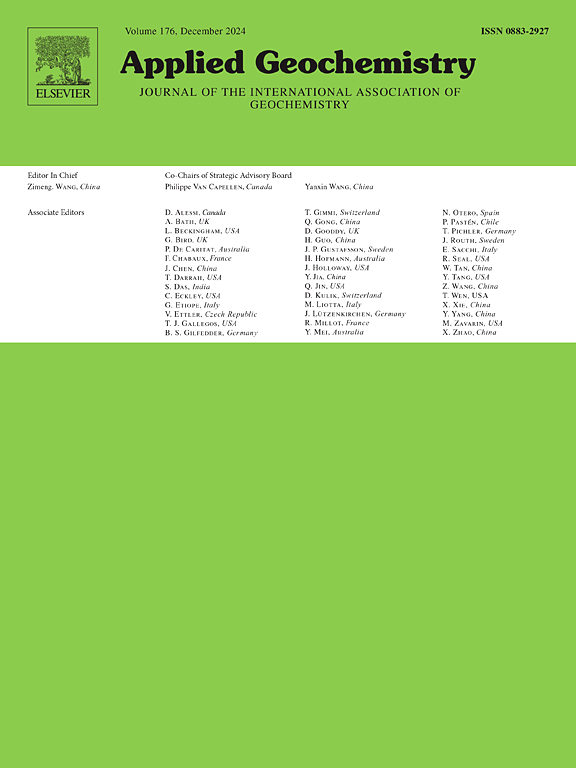Mobility of cobalt in mine waste: Evidence from a historic silver mining district in Canada
IF 3.1
3区 地球科学
Q1 GEOCHEMISTRY & GEOPHYSICS
引用次数: 0
Abstract
Historical mine tailings in the Cobalt Mining Camp in northern Ontario are both a source of environmental contamination and a potential resource of critical metals. Widespread mining in the Cobalt area during the 20th century resulted in dozens of unremediated mine sites and at least 18 unconfined tailings deposits, which contain potentially hazardous metals and metalloids, including arsenic (As). Economic metals, including cobalt (Co), also occur in the waste and could be recovered. Geochemical and mineralogical analyses of tailings and pond sediments were performed to assess the mobility of Co and other metal(loid)s in different depositional environments and implications for reprocessing of the mine wastes.
Tailings from four sites and benthic sediments from a pond impacted by tailings were characterized using ICP-ES/MS, various mineralogical techniques, and shake flask experiments. Cobalt concentrations in the tailings and sediments (96.8–8900 mg kg−1 Co; median = 470 mg kg−1) exceed Canadian environmental quality guidelines for residential soils (50 mg kg−1 Co) at all sample sites. Mineralogical investigations reveal that Co is hosted in oxidized alteration phases in near-surface tailings along with primary sulfide and arsenide minerals, which persist in this environment. In submerged tailings, Co is contained mainly within primary sulfide and arsenide minerals and reduced secondary phases. Cobalt-bearing chlorite is a major host of Co in half of the tailings samples, containing up to 50 wt% of the total Co content; the presence of Co-bearing chlorite may impact potential recovery of Co from the tailings in the future. The mineralogy of the benthic pond sediments is heterogeneous; however, Co is sequestered in both primary sulfide and arsenide minerals and authigenic reduced phases such as Co-bearing sulfide.
The results of shake flask experiments reveal that Co in the tailings and sediments dissolves in deionized water under oxidizing conditions. The concentration of Co in the leachate (30–126,000 μg L−1 Co) consistently exceeds Canadian water quality guidelines for Co (1 μg L−1). The results of this study provide new insight about the controls on metal(loid) mobility, including the processes which impact metal(loid) cycling in reduced pond sediments and the occurrence of Co-bearing chlorite in the tailings. In addition to characterizing the risks associated with mine waste contamination and informing long-term waste management decisions, the results of this study may be applied to understand the potential for future Co recovery from mine waste and sediments in the Cobalt area.
求助全文
约1分钟内获得全文
求助全文
来源期刊

Applied Geochemistry
地学-地球化学与地球物理
CiteScore
6.10
自引率
8.80%
发文量
272
审稿时长
65 days
期刊介绍:
Applied Geochemistry is an international journal devoted to publication of original research papers, rapid research communications and selected review papers in geochemistry and urban geochemistry which have some practical application to an aspect of human endeavour, such as the preservation of the environment, health, waste disposal and the search for resources. Papers on applications of inorganic, organic and isotope geochemistry and geochemical processes are therefore welcome provided they meet the main criterion. Spatial and temporal monitoring case studies are only of interest to our international readership if they present new ideas of broad application.
Topics covered include: (1) Environmental geochemistry (including natural and anthropogenic aspects, and protection and remediation strategies); (2) Hydrogeochemistry (surface and groundwater); (3) Medical (urban) geochemistry; (4) The search for energy resources (in particular unconventional oil and gas or emerging metal resources); (5) Energy exploitation (in particular geothermal energy and CCS); (6) Upgrading of energy and mineral resources where there is a direct geochemical application; and (7) Waste disposal, including nuclear waste disposal.
 求助内容:
求助内容: 应助结果提醒方式:
应助结果提醒方式:


